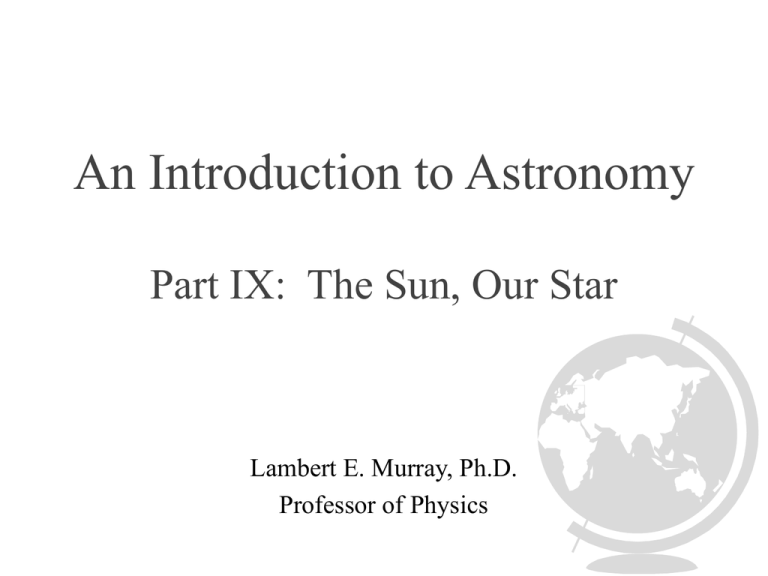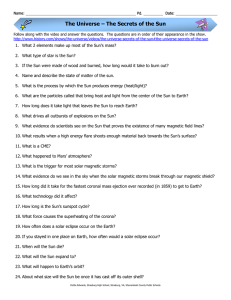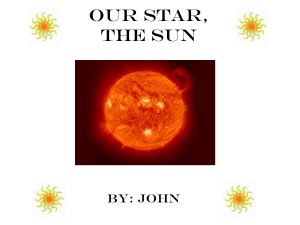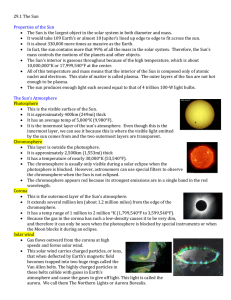Part II: Ideas in Conflict.
advertisement

An Introduction to Astronomy Part IX: The Sun, Our Star Lambert E. Murray, Ph.D. Professor of Physics Our Sun The Sun is a star – and as such, enables us to study stars up close (at least within 1 A.U.) Thus, understanding the Sun is the key to understanding the stars! Our Sun is the principle energy source for our solar system. It supplies the energy on the Earth for our weather and for life itself. It also supplies the high-energy radiation which causes the aurora. Size of the Sun The Sun is roughly 100 times the diameter of the Earth – more than one million Earths could be dropped into the Sun, with room left over. The density of the Sun is actually less than the Earth, about 1.4 g/cc, but The mass of the Sun is about 700 times greater than the mass of all the rest of the solar system combined – about 333,000 times the Earth’s mass. This mass basically controls the motion of all the other objects in the solar system. The Sun’s Atmosphere – That Part Visible to Us The Sun’s atmosphere is divided into three separate parts: – Photosphere – the visible surface of the Sun. – Chromosphere – a pinkish surface layer of the Sun’s atmosphere visible only during a total eclipse. – Corona – the Sun’s outer atmosphere which extends great distances away from the Sun’s surface. This part of the Sun’s atmosphere is also only visible during a total eclipse. The Photosphere This is the lowest of the three layers of the Sun’s atmosphere; it is the layer that determines the color of the Sun. The limb of the Sun is the apparent edge of the Sun. (This term is applied to the edge of any object in space.) A close-up of this surface shows features called granules. Granulation Patterns on the Sun’s Surface Granulation The granulation patterns on the surface of the Sun are dynamic, changing in time like the boiling of water in a pan. They are produced by convections currents in the Sun’s interior: heated areas rising from below the surface. – Doppler measurements confirm that the center of the granules are rising, while the edges are falling. – Each granule is about 1000 km across, or about the size of Texas. Changing Granulation Patterns on the Sun: (The images were taken in 2 minutes intervals.) Supergranulation In addition to the smaller granules on the Sun’s surface, there appear to be large areas of the Sun’s surface (about the size of the Earth) which rise and fall together. These are called “supergranules”. Convection in the surface layer of the Sun The Chromosphere The Chromosphere The Chromosphere is visible only during a total eclipse of the Sun. A close examination of the chromosphere at the limb of the Sun reveals “grass-like” features called spicules. These spicules appear to encircle regions of supergranulation. The Limb Spicules Outlining Supergranules The Corona The Corona Visible only during a total eclipse, the corona is the nearly transparent outer atmosphere of the Sun. It is composed of tenuous gases at extremely high temperatures (1-2 million Kelvin) – much hotter than the surface of the Sun. The corona may extend millions of miles out into space. Choronographs For years, the only time scientists could study the chromosphere or the corona was during a total eclipse. In recent years, the coronagraph has been developed. This instrument blocks out the disk of the Sun to allow the outer edge (the chromosphere) and the corona to be studied The next several images were taken with a choronograph. The Dynamic Chorona From these previous pictures, it should be clear that the corona is dynamic. Coronal activity appears to be linked with the appearance of Sunspots. The next image shows variations in coronal activity as correlated with sunspot activity. The Solar Corona During Solar Maxima Solar Minima Model of Sun’s Outer Atmosphere What causes the large temperature increase in the corona is not completely understood at present. Some type of magnetic disturbance is the most likely explanation. The Corona and the Solar Wind The Corona appears to be a continuous stream of particles being release from the Sun’s surface. This “Solar Wind” is made up mostly of highenergy electrons and protons. Millions of tons of matter each second is being spewed into interplanetary space. This Solar Wind is also very dynamic and variable. Sunspots and Solar Activity During certain times the solar disk is completely devoid of apparent activity – this is the time of the quiet sun. At other times, there appear to be magnetic “storms” that move across the Sun’s surface. The severity and number of these storms varies greatly from time to time. The Solar Disk Active Quiet The Solar Cycle Sunspot activity has been monitored for several centuries. The number of sunspots on the Sun’s surface appears to go through a cycle that has a period of approximately 11 years. The Sunspot cycle is plotted in the next slide over a period of about 100 years and shows not only the number of sunspots, but their locations on the solar disk in the form of “butterfly” diagrams. Long-Period Solar Cycles • There appears to be another solar cycle superimposed upon the 11-year cycle, as seen on the next slide – notice the minimum every 100 years. • The period from 1645 - 1715 when there were almost no visible sunspots and a dearth of any solar activity is known as the “Maunder minimum”. • There is some evidence that there were very abnormal weather patterns during this time period – indicating a possible link between solar activity and the weather. The Maunder Minimum SunSpot Record Sunspots: A Closer Look Umbra Penumbra Sunspots look like dark blemishes on the solar disk. These areas are not really dark, however, they are just not as bright as the surrounding areas. Groups of Sunspots often appear in groups – quite often in pairs. These sunspot pairs appear to move on the Sun’s surface as the Sun rotates – gradually moving from higher latitudes toward the Solar equator. Sunspots Source of Sunspots In 1908 George Hale discovered that sunspots were associated with intense magnetic fields – thousands of times larger than the average solar magnetic field. These magnetic fields can be measured using the Zeeman effect – where spectral lines are split proportional to the strength of the magnetic field. Zeeman Splitting at a Sunspot Magnetic Polarization Studies The Zeeman effect also causes the light from these strong magnetic field regions to be polarized. The polarization direction is associated with the direction of the magnetic fields. A magnetogram, a photograph based upon this polarization effect, is shown on the next page: – On this image one polarity is yellow, while the other is purple. – The sunspots appear to occur in matching pairs of opposite polarity – The polarity is reversed in opposite hemispheres and remains the same over an 11-year cycle, then reverses! A Magnetogram of the Sun The 22-year Solar Cycle Since the directions of the magnetic fields in the northern and southern hemisphere of the Sun reverse every 11-years, it appears that the 11-year sunspot cycle is actually a 22-year cycle. The cycle of sunspot activity appears to be associated with a twisting of the Sun’s internal magnetic field lines. Plages and Filaments Associated with the Sunspots are other features on the Solar disk. The next slide is an image of the Sun taken with an H-alpha filter (looking at the hydrogen emission line). You will see bright areas called plages, which are closely associated with sunspot activity, and dark snake-like features called filaments. Filaments and Plages Filaments and Prominences The dark filament observed in the last slide is actually a stream of ionized gas trapped in the Sun’s magnetic field. These gases have been cooled, and are thus not as bright as the surface gases. When observed from above the Sun’s surface they appear darker than the rest of the surface. However, when observed from the side (above the edge of the Sun) they appear quite bright, and are called prominences. Filament Prominence Solar Flares Flares are the most violent events on the surface of the Sun. They are usually associated with sunspot groups. The material of a flare is heated to extremely high temperatures. Large amounts of high-energy particles and radiation are emitted into space. Active SUN 2/6/2000 large flare Time Sequence of a Flare Time sequence of eruptive prominence (~1½ hr intervals) Large Flares can be Deadly A Flare is a violent eruption from the surface which is usually over in about 20 minutes. The x-rays and ultraviolet rays emitted from the flare arrive at the earth in about 8 minutes. The highest energy particles streaming out from the Sun can reach the Earth within about 20 to 30 minutes but will reach a peak only after several hours or perhaps days. An astronaut exposed in space to the high-energy particles from a large solar flare can literally be cooked. Protection from Solar Events Fortunately, the Earth is shielded from these high-energy events by the Earth’s magnetic field, which diverts the charged particles toward the poles, and by the atmosphere which absorbs much of the excess energy. The High-Energy Particles Follow the Sun’s Magnetic Field Other Effects of Solar Flares These high-energy bursts can disrupt radio communication on Earth They increase auroral activity They may create power surges in electrical power grids, burning out circuits. The Sun’s Interior Solar Interior Current solar models describe three regions inside the Sun – Core - where thermonuclear reactions power the sun – Radiative zone - where photons carry energy away from the core – Convective zone - where convection of gases carries energy away from the core Gravitational Attraction vs. Radiation Pressure The material making up the Sun is being pulled toward the center by gravity. Radiation pressure (the outward force of the photons and other elementary particles) is pushing the gases outward. These two forces are in equilibrium inside the Sun. – If the radiation pressure were to decrease, the Sun would collapse. – If the radiation pressure were to increase, the Sun would expand. Energy Source for Stars During the last 200 years, several different energy sources for the Sun have been proposed. However, all fail to provide enough energy for the Sun to have provided light to our solar system for the past 3-5 billion years except one: nuclear fusion. Gravitational pressure of the Sun’s great mass causes the core to reach temperatures of 15 million Kelvins. Under these conditions Hydrogen (H) can be fused together to make a heavier element Helium (He) liberating neutrinos and energy. Nuclear Fusion According to Einstein’s theory of relativity, E = mc2 This equation indicates the possibility of converting mass into energy. When hydrogen is converted into helium, only about 0.7% of the mass is converted into energy. However, because c is so large, every gram of matter converted produces and amount of energy equivalent to that produced by 300,000 tons of coal. The Sun must convert 600 million metric tons of hydrogen into helium every second to maintain its present luminosity. However, there is enough hydrogen still in the Sun to provide energy for at least another 5 billion years! End of Part IX








